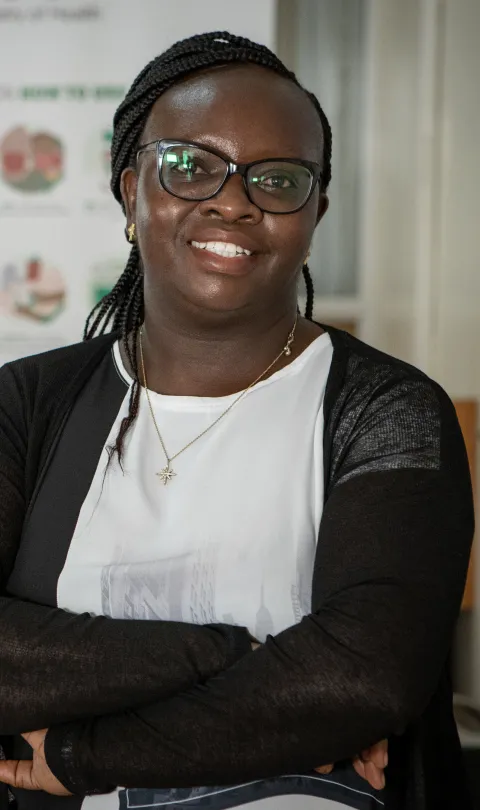Dr. Evelyn Wesangula leads Kenya’s response to antimicrobial resistance. A pharmacist by training, as Head of the Patient and Health Worker Safety Division within Kenya’s Ministry of Health and as the National Focal Point on antimicrobial resistance (AMR), Dr. Wesangula supports the implementation of the Kenya’s National Action Plan on AMR.
This World Antimicrobial Awareness Week, Dr. Evelyn spoke to us about the scale of the threat posed by AMR, and the action needed to fuel progress, in Kenya and beyond.
What threat does AMR pose to people’s health and well-being?
If we don't take action now, our communities will be in danger. People face the danger of acquiring infections that have limited or no treatment options. Ultimately, this increases the costs of seeking health care, and eventually increases chances of dying from infections that were once treatable. If nothing changes in the way we handle antimicrobial agents, by 2050, 10 million people will die every year from infections caused by resistant microorganisms.
The economic impact of AMR is stark. If more people die from untreatable infections, more communities will lose breadwinners and ultimately livelihoods. If a person is in hospital for a prolonged period of time, they require more finances to pay for the hospital bills. In addition to this, we know that when a person is admitted to a health care facility with an infection that is resistant to multiple drugs, the chances of getting treatment with cheaper medicine are very low. So the treatment eventually becomes very expensive. This can drive families and communities into poverty if the costs of health care will be made out of pocket.
AMR is a barrier to achieving all of the Sustainable Development Goals (SDGs), not just SDG 3 on health. When farmers lose income, we cannot eliminate hunger. If agricultural productivity is low, you cannot promote people’s health. If someone cannot access effective medicines or food, their safety is endangered. So achieving the SDGs becomes elusive.
How did you become interested in and involved in AMR?
I began my career in a hospital, actively engaging in hospital infection prevention and control and monitoring antimicrobial use and resistance patterns. It was at the Kenya Medical Training College that I got in touch with the Global Antibiotic Resistance Partnership—a working group of like-minded people in the veterinarian and healthcare sectors working on AMR from a research perspective.
As a pharmacist reviewing data being shared by researchers and understanding the dangers posed by AMR, I chose to focus on antimicrobial resistance and infection prevention and control from a policy perspective to provide a platform for the dissemination and uptake of actionable policies.
For a long time, the AMR agenda in Kenya was driven by researchers and those in academia, and there was a real gap between policy actions and research recommendations. Leveraging on the National Infection Prevention and Control program, we established an AMR program with a multi-sectoral team, following recommendations from the National Infection Prevention and Control Advisory Committee to establish a multisectoral AMR coordination mechanism. That is how our journey of working on the AMR program at the national level began.
What are the data challenges related to AMR?
The lack of quality data on AMR and antimicrobial use across the multiple sectors limits our understanding of its drivers, pattern, and burden, and ultimately poses a challenge to effectively communicate the urgency of taking action to prevent the emergence and spread of AMR.
Action against AMR is a shared responsibility, and everybody has a role to play: citizens, policymakers, and professionals across the key sectors in government: health, agriculture, livestock and the environment). This study has reinforced the important value of citizen-generated data in bringing out the voices of citizens on issues that matter to them.
Sadly, it’s also reinforced what we’re missing: the insights which we don’t get from routine surveillance data. Citizen-generated data is a powerful tool for us to understand and tackle AMR. We need this kind of engagement now more than ever, because macro-level behavior change begins with community engagement.
What will it take to stop the spread of AMR?
One of the things I would like to see is communities taking charge of their own health, and that can only happen if we continue to engage them. So that means we must strengthen the programs that engage citizens in this response as we strengthen the health system to address health system challenges in effective surveillance, infection prevention and control, and appropriate use of medicines.
This joint effort can’t be ad hoc, but must be incorporated into our daily interactions. We’ve already got some of this in place in Kenya. We have community health volunteers. So, can we strengthen the role of community health volunteers? Can we develop incentives and programs that will keep them going as champions for appropriate health seeking behaviors? I firmly believe it’s possible.
Looking ahead, what are your priorities for scaling up the fight against AMR?
We’ve got to continue gathering people’s everyday perspectives on AMR, and using this to shape policy. This bolsters not only the formulation of policy, but also its implementation. Data that's generated by citizens that is used to inform policies that affect the same citizens, there’s better ownership of actions taken because they know the proposal actually came from them. Then, these types of policy decisions tend to have a greater impact. I look forward to seeing the community engagement structures strengthened so that our advocacy and educational actions continue and through that we’ll be able to generate more information that can make a difference in our policy processes.

